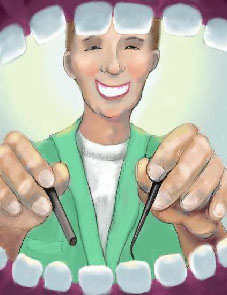By the time we reach our 60’s, many of us have suffered the pain and indignities of a root canal. And once you’ve had one, you aren’t likely to forget the experience. Along with the painful injection of numbing solutions in your gums, a large, rubbery sheet is attached to metal pieces that are placed in your mouth and through a hole in the middle, that rubbery piece is placed over your tooth which is about to be gouged. And then the drilling, probing and packing commence.
Once the root canal is completed, the tooth is now dead and must be capped or crowned. The pain is gone, but at what cost?
There is no real way to sterilize a tooth during a root canal. Those dead teeth may harbor bacteria after the procedure is completed. Said bacteria can incubate and eventually travel into the bloodstream, causing all kinds of medical problems.
The American Dental Association claims that root canals are safe, but I could find no research to verify that point. In fact, there are studies that suggest the opposite.
Dr. Weston A. Price was a dentist who studied the teeth, bones and diets of native people living without modern food. Around 1990, Price had been treating persistent infections involving root canals and became suspicious that root canaled teeth remained infected in spite of treatment. One day he recommended a patient who had been wheelchair bound for 6 years have her root-canaled tooth extracted. He then implanted that tooth, with its root canal intact, in a rabbit. The rabbit soon came down with the same crippling arthritis that the woman had lived with for years. The woman’s symptoms disappeared, and she was able to walk unassisted. Ten days later, the rabbit died from infection. Price believed it was impossible to completely sterilize a tooth. He continued his studies and found many chronic, degenerative diseases began from root canaled teeth.
Dr. Robert Jones, in researching the correlation between root canals and breast cancer, believed the connection was strong.
Dr. Josef Issers said that in 40 years of treating terminal cancer patients, 97% of his cancer patients had root-canaled teeth. This article suggested that if these physicians are correct, the cure for or prevention of cancer may be as simple as having a tooth pulled and then rebuilding the immune system. (undergroundhealthreporter.com/the-dangers-of-root-canals/#axzz3ROMQQVK; )
Dentist Dr. George Meinig, one of the founders of the American Association of Endodontists, wrote in his book – The Root Canal Coverup – that a root canal is “paramount to leaving an organ that dies to rot inside your body.”
“During the root canal procedure, the nerve and pulp are removed and the inside of the tooth is cleaned and sealed. But sealing the main canals does not account for the thousands of side canals that branch off each tooth.”
That doesn’t give me a lot of confidence in the procedure, even though I have experienced several root canal procedures in my life.
This research gives us seniors something to think about. If you have issues with a compromised immune system, perhaps you’ll want to think twice about undergoing a suggested root canal. Extraction, followed by an implant, may be more pricey, but it sure sounds a lot safer!
Just my opinion!
